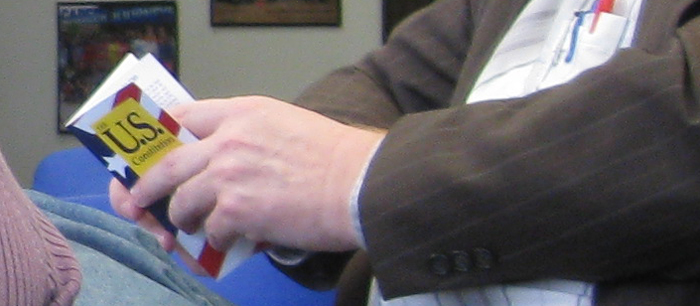The United States Constitution, the oldest and shortest written constitution in the world, was signed on September 17, 1787. To commemorate this event, we at IU East are celebrating Constitution Day with activities, a contest and, of course, learning.
Constitution Day events will be held at the Graf on Monday, September 19th, from 10:00 am to 2:00 pm. You can enjoy cider and donuts as you pick up your own copy of the Constitution, register to vote and enter a contest to win one of three cash prizes. What’s the contest? All you have to do is recite the Preamble to the Constitution anytime between now and the morning of September 19th and send the video to our Constitution Day Box folder. Check out the LibGuide with Constitution Day resources for information on Constitution Day, a short quiz and other interesting info.
But the Constitution is much more substantial than just its Preamble, which many of us memorized in school. With a total of less than 8000 words, including amendments, it takes less than a half hour to read in its entirety. A style committee was appointed to finalize the language and form of the document, allowing for readability and a unified format. The entire process of developing the Constitution, from arguments to signatures, took about 100 days to complete. But don’t take our word for these facts. Read the Constitution for yourself, plus other documents from the Constitutional Convention.
If you’re fascinated by the process of creating a new national government and want to learn more about how our own was founded, you might want to read what some of our founders had to write about it. John Marshall, first Chief Justice of the United States, wrote extensively about it, and his papers were published posthumously in 1839 in Boston. If you would prefer an eyewitness account to the founding of our nation, the autobiography of Silas Talbot, Revolutionary War soldier and commander of the Continental Navy, may be appealing. If you’re more interested in the future of the Constitution, the outlook of scholar Larry Sabato may be what you’re looking for. After the Constitution was drafted, however, many, many individuals commented on it from a number of angles. One of the more fascinating of these commentaries is a speech delivered by abolitionist Frederick Douglass on the nature of the Constitution as a pro- or anti-slavery document. The Supreme Court also continues to analyze and interpret the Constitution, and the Government Publishing Office produces the Court’s commentary on a regular basis.
In order to learn as much about the Constitution as possible, it would help to know more about the times in which the Constitution was drafted. Newspapers, broadsides and pamphlets, published widely in the US Colonies, the West Indies and Great Britain, recorded the daily and weekly opinions of journalists, editors and the occasional everyday citizen. Take a look at these important works with the Burney collection, which focuses on newspapers, or the Eighteenth Century Collections Online database, which focuses on pamphlets, books and ephemera. Other broad-spectrum databases, such as JSTOR, include analysis and historical context for the events surrounding the signing of the Constitution and the lives of the nation’s founders.
Constitution Day is a celebration of the foundation of the United States. Separate from the Fourth of July, which focuses on freedom and liberation, Constitution Day serves to remind us that we did not retain our independence without hard work, consensus on a national level and the contributions of disparate Americans. Want to know more? Ask a librarian by contacting us at iueref@iue.edu



